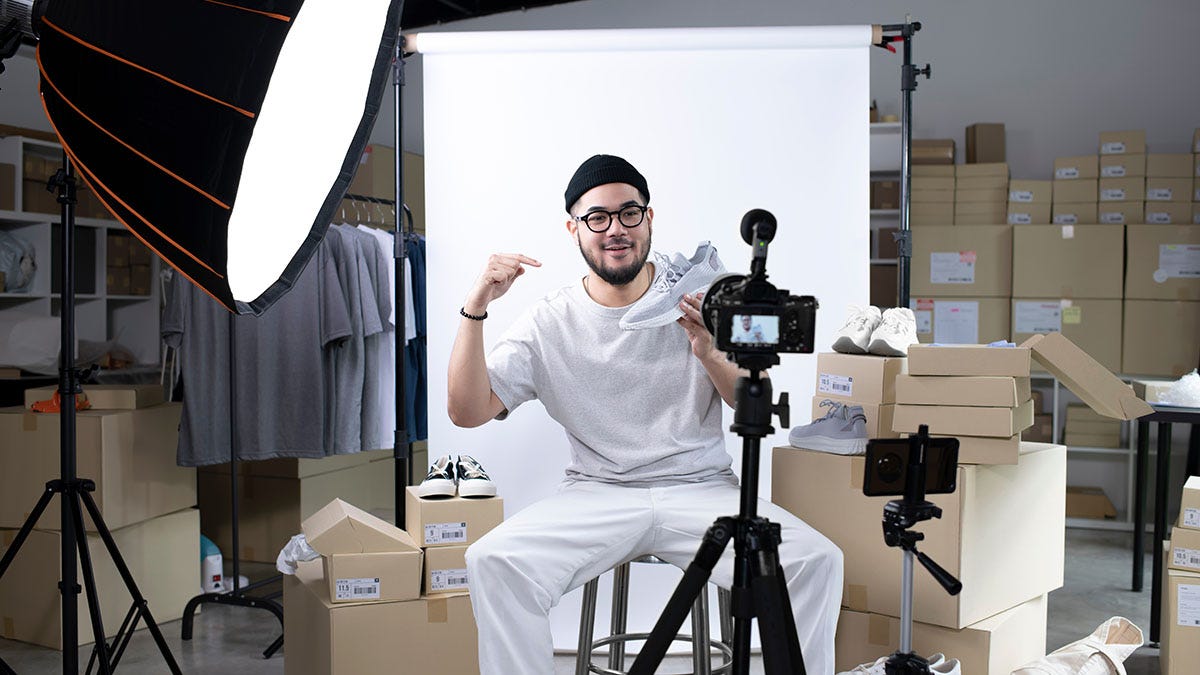how the creator economy became a quarter of a trillion dollar scam
Millions dream of going viral and making a fortune being creative. Because an entire industry is lying to them that it's never been easier...
With AI and increasing automation knocking out rung after rung from the entry levels of every career that doesn’t require human interaction or complex licensing, there’s a burning question on millions of minds. What do we do when up to a third of us can no longer get a job that will pay the bills?
Why, become creators of course! In case you haven’t heard, content creation is now a $250 billion economic sector and is projected to nearly double in just a few years. So get that camera ready and buy that ring light you’ve been wishlisting. The web wants to hear from you and desperate advertisers are ready to give you more money than a neurosurgeon sees per year. Or, write on a platform like Substack and strike it rich by getting your audience to pay for the privilege of reading your musings.
Sounds easy, right? Maybe a little too good to be true? Well, like all things that sound too good to be true, it is. The reality is that the creator economy — which we all need to remember is just a fancy word for posting stuff online and hoping you get a cut of a widget’s sale or get hired to read an ad — is kind of a pyramid scheme. Well, maybe it isn’t one technically speaking, but as a sleazy car salesman looking guy or a Mormon mom might say, it’s triangle shaped.
Allow me to explain. A typical social media user has 200 to 800 followers depending on the platform. There are about five billion of those, give or take a hundred million or so bots here and there. Out of those, accounts with more than a million followers are measured in the thousands, and many are celebrities who were already famous prior to joining any social network.
Even by the most generous definition, only 2.4% of all social media users fall into the ranks of influencers, and that definition starts with as few as a thousand followers, or nano-influencers. As you travel up the stats, the curve towards the million mark starts to get extremely asymptotic.
Which makes sense. With infinite scrolling and very literally hundreds of millions users trying to get your attention, it’s a statistical inevitability that 99.99% of them will never get traction while already massive, popular creators who already have momentum and come across your screen again and again keep growing and sucking out the oxygen in the room of finite attention spans with only so many hours in the day to browse.
Yes, TikTok may have about 100,000 influencers. Out of 1.8 billion users. Instagram or YouTube may have a million of them. But they also have between two and nearly three billion users, respectively. You’re competing against the population of a continent with every post in an environment where arbitrary algorithms in constant flux determine if you go viral or not. I don’t know about you, but I’m not a huge fan of those odds.
how to be rich and famous. without the rich part.
But suppose you make it to the big leagues. Your follower count now has that vaunted M next to it. Woo! Well, the average social media payout for a thousand views tends to come out to a few dollars. Some platforms pay a lot more, others not so much, others have a complex formula, and the payouts always fluctuate. Bottom line is that even an account with millions of followers is often making the equivalent of a middle class job but without the benefits, time off, or knowing what they’ll get on payday.
We tend to associate having a lot of followers or seeing entertainers everywhere with massive financial windfalls. I’ll never forget telling someone with whom I worked that I did radio and was making some money off a blog back when that was far easier. She incredulously asked what I was still doing at a corporate office, and had quite a bit of trouble understanding that my day job accounted for over 90% of my income.
In her mind, as in the minds of countless people to this day, doing anything for public consumption means that you’re a celebrity being sought out for mainstream projects like network TV or cable. And yet, that hasn’t been the case for the better part of two decades, as you can now be very famous but only in limited circles, and without any of the material or financial payoff to go along with it.
For example, if I were to tell you that Catturd posted something on the now swastika-tattooed corpse of Twitter, odds are you would have zero idea who and what the hell I was talking about, or assume that I was into some New Age divination technique that requires digging in a litter box and be rather concerned. Now, consider that this feline feces themed merchant of rage bait MAGA agitprop has over 3.5 million followers but yet is furious that his 12 to 15 hours of daily posting aren’t paying his bills.
You see, even having millions of followers doesn’t mean as much anymore. In those heady days of ancient internet past, when people followed you, it meant they saw all your content, or at least much of it. The platforms took it as an order. I like this kind of stuff and this person. Give me more of them and that.
Now, it’s merely a suggestion that’s taken about as seriously a child begging for a toy at a pharmacy. Yeah, yeah, sure, you want to see more Jane Q. Public. Well, we have Jane Q. Public at home. Why yes, she’s a full time troll and you won’t believe the kind of horrible shit she posts for your attention. Check that out! Isn’t that more enraging? Don’t you want to leave an angry reply? Or try being even edgier than her? And don’t forget to look at all those ads. Maybe buy something too. It’s cheap and easy.
This is not just me being sarcastic or satirical. Darth Zuckerberg, the Overlord of the Meta Imperium himself, says as much. If you’ve noticed that you now have to go out of your way to see posts from the people you actually follow or know on every Meta platform other than WhatsApp, that’s not a fluke or a bug. It’s very intentional. Your follower or following lists now mean very little. It’s all about what will get you to click one more time or scroll for one more second.
Okay, what about selling your content directly to your audience, like on OnlyStacks… err… GhostPress… I mean Substack. You can market directly to readers, viewers, and listeners, and hope they’ll support you without having to constantly battle with some nasty algorithm that once again decided on a meme of the week that isn’t yours. This seems like a much more sure thing, right?
Except it’s also not. As writer S Peter Davis very accurately detailed, you would really be selling a luxury service that a) most people wouldn’t want to buy, b) would be one of the first expenses to be cut in a financial downturn or an inflationary spike — good thing neither of those happened anytime in recent history or now, huh? — and c) that money is more likely to go to an already well established name instead of the random writer who may or may not be any good.
Almost all of the people making money on Substack, or OnlyFans, or Patreon, are just paying some bills with it rather than making anywhere close to a full time living. They, much like me, have these side and hobby projects as creative outlets after they finish their day jobs and household chores. And if they decide that they can make a full time living off nothing but their newsletters, they’re going to be sorely disappointed.
the unfortunate rise of the meta-influencer
Here’s the thing. I don’t expect people to hand over their hard earned money just for a chance to read a post or watch a video. If they think that what I do is worth it and pay me, that’s amazing. But I’m too jaded to assume this is the default setting and there’s some magical percentage of people who always join, pay, and enjoy for years on end.
Yet, looking at the web, you’d think that there’s no better time to start your career as a soon-to-be famous influencer. There are seemingly hundreds of thousands of people happy to sell you a course, a guide, a tutorial, or recommend some gear and tools that will get you started. Just make sure to click the special link under their video or in the post to get them the best affiliate link commis… uhh… I mean to get yourself the best price. Yeah, that’s it. The best price on all that important influencer gear.
This is perhaps the scammiest part of the creator economy, one that sees it as a giant digital gold rush and is happy to sell the shovels, and pans, and detectors to all those prospectors with dollar signs for pupils.
A great deal of influencing is very much an MLM style encouragement for others to be influencers and buy something to ostensibly help them. Of course, since you will owe most of your success to algorithms and networking, none of those things can possibly help you unless it’s a direct link to have someone at a social media platform give you a special boost on a regular basis that helps you go viral at least once a month.
In their courses, they will tell you how to write listicles about “financial tips and tricks” and the power of clickbait headlines in between English 101 writing advice or straight up telling you to use ChatGPT and spam social media ten to twenty times a day. Oh, I almost forgot. They will also teach you to dropship and sell shitcoins to followers with promises of making them rich if they just buy in now.
If you follow their advice, the best case scenario is that you’ll briefly make a chunk of change after investing an inordinate amount of time copying whatever content does well for your much more successful competitors and obsess about stats, thumbnails, and keywords, spamming platforms with soulless time sucks and penny grabs doing your part in killing the web along with the ad, porn, and click fraud bots. The worst is that you’ll be thousands of dollars in the hole after building out your studio to scream into the void in 4K that’s still poorly lit and shoddily edited.
It’s this meta-creator epidemic that’s adding to the loud complaints about the state of the internet, turning once relatable, creative people who were genuinely enjoying the process of creating videos, art, podcasts, and blogs, sharing the passions, growing as they learned more, into living content farms regularly churning out yet another inferior copy of whatever was trending last.
It’s kind of like a charming mom and pop burger spot which was fast and loose with extra fries being bought out by a corporate chain, re-decorated with minimalism that verges on monochromatic punishment, and the food blanded down according to the palette of a robot from Boringsville, East Idayoming. What was once a passion project is now a soulless cash grab we still visit on reflex, hoping they’ll realize their mistakes and maybe, just maybe, go back to what made them good back in their heyday.
And you can tell this is draining creators’ souls when they take sudden hiatuses for a month or two, or slow their content to a trickle only to come back with videos in which they talk about no longer making the kind of content they want to make and feeling as if they’re floundering or spinning their wheels instead of growing and having fun.
So, what have we learned today? We learned that almost everyone who tries to be the web’s next viral sensation has a slightly better chance of being brained by a meteor if we consider today’s algorithmic hellscape. We also learned that even having millions of followers doesn’t mean what it used to ten years ago. And we saw how a hobby in the early 2010s twisted itself into a brutal business overran with formulaic, MLM style meta-content aimed at selling the dream of becoming a rich online celebrity.
By extension, we can also conclude that this is why tools meant for creators will never live up to the hype for 99.8% of their users, and a good portion of that 0.2% for which it does will already be big names with massive, built-in followings; famous writers and viral political pundits on Substack, iconic comic artists on Patreon, and porn stars who long ago became industry icons dominating the top tier of OnlyFans.
to create, perchance to influence
Now, after beating you over the head with all these sad, frustrating facts, you may be looking at your phone or vlogging camera, sighing, and preparing to go through all the stages of grief. But don’t do that yet. Not all is lost.
Remember what I said about the first successful creators? They were people who did what they did because they enjoyed it as an outlet, and tried to push themselves and their craft further. It was a passion project. A hobby. A release from the day job. And it just so happened that a lot of people caught that infectious passion, encouraged the hobby, and shared it with friends and their own social circles.
The reason why so many of them fell off or quit is because the hobby became a job in which they had to pump out more and more content to hit more and more trends on platforms that turned into ravenous, insatiable maws constantly demanding more and more content to cram full of ads. They had to hit certain metrics to get paid, and when they didn’t use the formulas the algorithms demanded, they felt the blowback right in the wallet. It wasn’t their fault. It’s just how the world warped around them.
So, the message here is not to just give up on doing anything creative online because, to borrow from Marvin the Paranoid Android, this will all end in tears. If I really believed that, why would I even try to write this, or make the videos I linked?
The message is that if if you’re doing something on the creative side because you are expecting the platforms to make it rain once you put out enough videos, that’s almost certainly not going to happen unless you’re extremely talented and extremely lucky. It is, indeed, a long way to the top, as per AC/DC. But if you focus on making things just for the sake of having fun, learning, experimenting, and indulging your creative side, it will help set your expectations in reality and save your sanity.
We’re pushed so hard to make things for profit, while ironically, your audience wants a more creative, new, passion project driven approach. People appreciate work created not because it was due and there was a paycheck to collect, but because the creators wanted to make it and go through the process of trial, error, learning, and growing. We may be too jaded to believe it, but people still appreciate fervor and ambition, and will cheer for the culmination of hard work where the result was earned, not spat out by a generative AI platform to take up space and vacuum up views.
Humans want to create, to dream, to try new things, to express themselves. Yes, there is apparently a quarter trillion dollar market for that, but the vast majority of that goes to a very small percentage of all creatives, the distribution is wildly asymptotic, and AI has been pillaging this revenue share.
You can look at it as “why bother making things if I won’t be able to leave my day job to do what I love?” and either give up completely or go down the rabbit hole of meta-influencers and their siren song of hustle and grind to a soulless formula that seems an awful lot like working for a digital marketing department of any boring corporation. Or you can look at it as “I could just create for the fun of it, share it with the world and see how far I can go instead of making it a 5 to 9 side hustle.”
At the end of the day, being creative online is not the scam. The scam is selling those creatives on a dream that it’s now easier than ever to become a superstar by doing it, especially if you buy the right gear and use the right tools, which, oh by the way, are now on sale with code CREATE if you click on the link from the video you’re watching or on the site for the podcast you’re listening to right now.
So, don’t fall for it and go out, create, and have fun with it as if your financial future is not at all dependent on how many views your next post, video, comic, or song will hit. Because at the end of the day, statistically, it really doesn’t.





